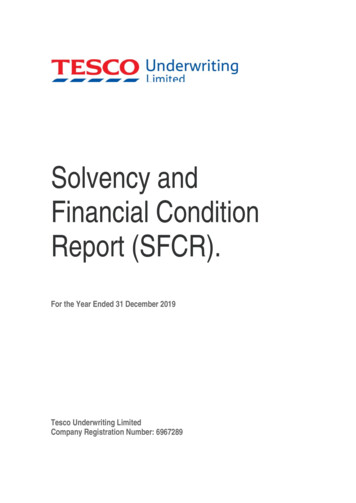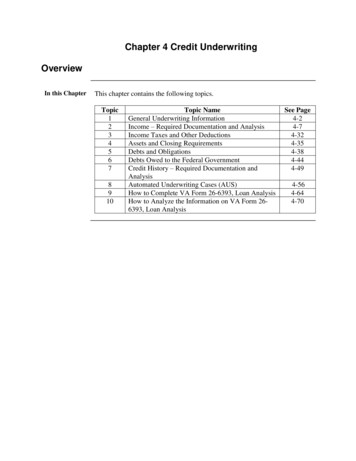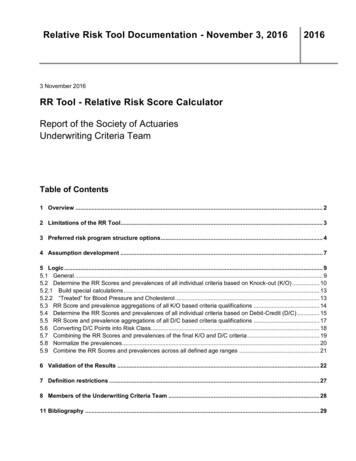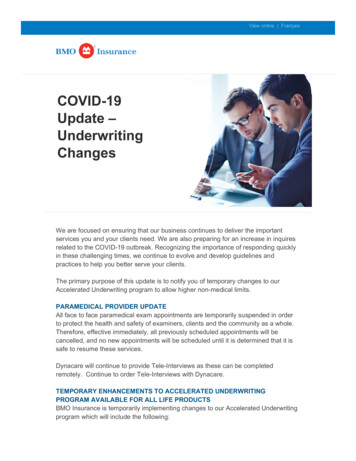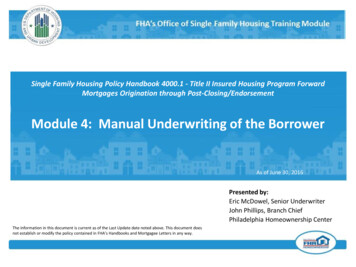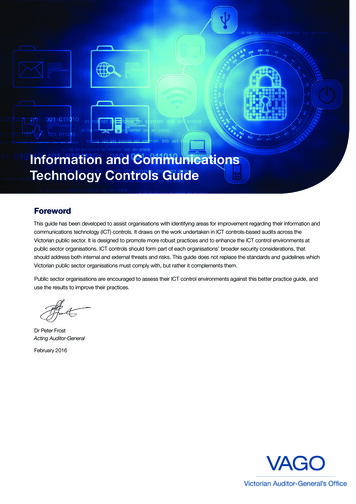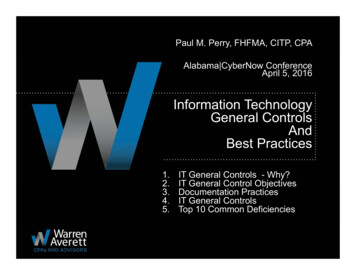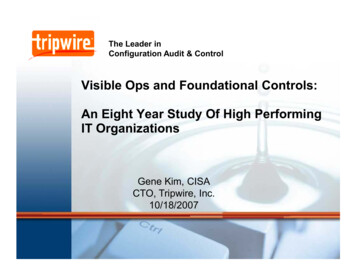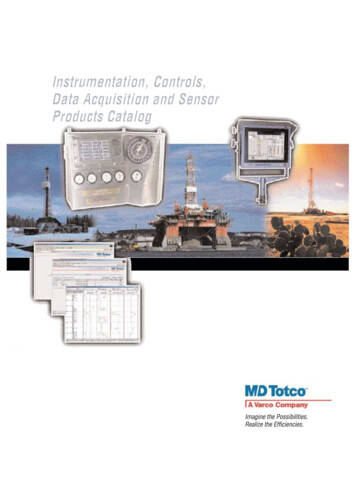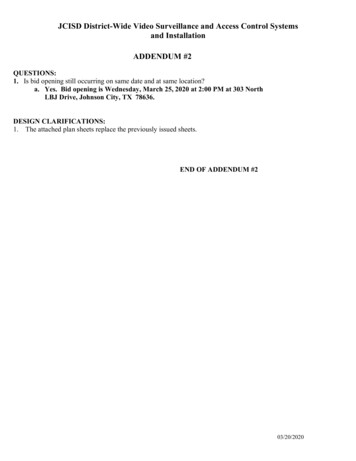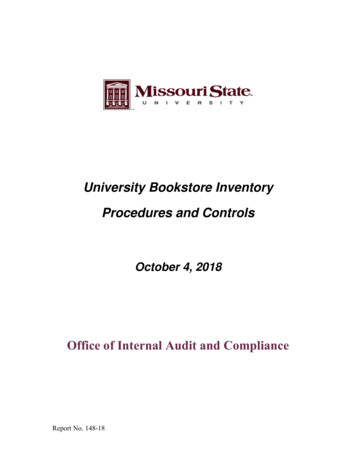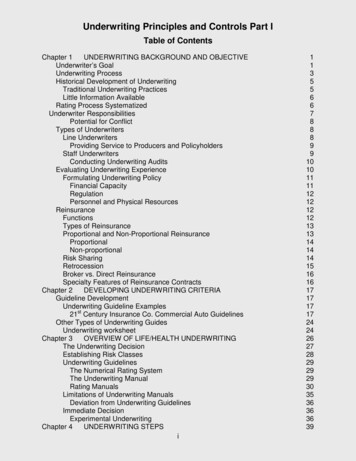
Transcription
Underwriting Principles and Controls Part ITable of ContentsChapter 1UNDERWRITING BACKGROUND AND OBJECTIVEUnderwriter’s GoalUnderwriting ProcessHistorical Development of UnderwritingTraditional Underwriting PracticesLittle Information AvailableRating Process SystematizedUnderwriter ResponsibilitiesPotential for ConflictTypes of UnderwritersLine UnderwritersProviding Service to Producers and PolicyholdersStaff UnderwritersConducting Underwriting AuditsEvaluating Underwriting ExperienceFormulating Underwriting PolicyFinancial CapacityRegulationPersonnel and Physical ResourcesReinsuranceFunctionsTypes of ReinsuranceProportional and Non-Proportional ReinsuranceProportionalNon-proportionalRisk SharingRetrocessionBroker vs. Direct ReinsuranceSpecialty Features of Reinsurance ContractsChapter 2DEVELOPING UNDERWRITING CRITERIAGuideline DevelopmentUnderwriting Guideline Examples21st Century Insurance Co. Commercial Auto GuidelinesOther Types of Underwriting GuidesUnderwriting worksheetChapter 3OVERVIEW OF LIFE/HEALTH UNDERWRITINGThe Underwriting DecisionEstablishing Risk ClassesUnderwriting GuidelinesThe Numerical Rating SystemThe Underwriting ManualRating ManualsLimitations of Underwriting ManualsDeviation from Underwriting GuidelinesImmediate DecisionExperimental UnderwritingChapter 4UNDERWRITING 6171717172424262728292929303536363639
Preliminary ProcessingInformation for Current FilesCase Assignment SystemsUnderwriting the CaseInformation SourcesProperty Casualty Underwriting DevelopmentProducersApplicationsInspection ReportsGovernment RecordsFinancial Rating ServicesLoss DataClaim FilesUnderwriting, Pricing and the ActuaryActuary and ReservingSummary of Actuarial PrinciplesMust Know Whereof They SpeakChapter 5PRICING INSURANCE PRODUCTSPricing ObjectivesAdequate RatesRatemaking ResponsibilityRatemaking Process and TermsRatemaking ProcessRatemaking IllustrationRatemaking FactorsRatemaking TermsLoss Reserves EstimationPaid LossesReported But Not Paid LossesIncurred But Not Reported (IBNR) LossesInvestment IncomeOther FactorsChapter 6RATEMAKING METHODSLoss Adjustment Expense and Ultimate LossProvision for Expense and ProfitTable 7-1Combining the ConceptsLAE and Ultimate Loss EstimatesAddressing ReservesEstimate of lossesCumulative Loss Development EstimatesUltimate Losses EstimateApply TrendingAdjust LevelsDetermining Auto and Homeowners RatesDouble StandardUsing Historic CostLoss Development FactorsRate AnalysisRatemaking ComponentsMechanics of Class 7172727373
Pure Premium Ratemaking MethodLoss Ratio Ratemaking MethodOther Types of RatingLife Insurance RatemakingAdoption of 2001 Mortality TableNSP as Example BaseTable 6-1Ratemaking VariesChapter 7LEGAL ISSUES AFFECTING UNDERWRITINGTitle V of ADATitle V – Insurance UnderwritingCourt DecisionsFunctions and Impact of Underwriting and Risk ClassificationUnderwriter Binds the Insurer- Waiver and EstoppelEstoppelWaiverUsed InterchangeablyParol Evidence RuleUnderwriting Aspects Affecting Legal PositionChapter 8ECONOMICS OF UNDERWRITING RISKAdverse SelectionConcept of Risk and ReturnPortfolio Theory and UnderwritingGoal of UnderwritingDetermining Underwriting MarginGetting Together the Buyers and SellersMissing Puzzle PieceFrictional CostsRisk Information RequiredWhat You Don’t Know Benefit of CommissionsGraph 8-1Enter the IntermediariesThe Agent or Producer is Market MakerGoing, Going .Accurate Information to Quantify RiskGrowth Rates and Underwriting RisksInsurance: A Risk to the Economy?The Economics of Insurance: Life's a GambleThe Insurance Industry's Own Catastrophic EventA Damper on the 19191929394949596969797989999100101102102102104105
Underwriting Principles and Controls Part IChapter 1UNDERWRITING BACKGROUND ANDOBJECTIVEBasically, underwriting consists of two components; risk assessment and pricing.Successful underwriting requires a system of risk selection to obtain a group in whichloss results will be reasonably predictable by means of the law of averages. Toaccomplish this goal there must be a balance between obtaining volume and obtaininghomogeneous risks. If an insurance company issuing individual life policies, forinstance, adopted such strict standards that it would only accept individuals who werepractically perfect physically, ideal from a moral standpoint, and in risk-free occupations,there would be only a very small group from which to choose. Such a group would bevery homogeneous, with all the risk units--in this case the individual lives--subject toabout the same chance of loss. But the mass or volume of risk units would be verysmall, and thus the predictability of loss might be adversely affected. Another elemententering in to make selection of such a group impractical would be that selectionprocedures necessary to obtain this near-perfect set of individuals. The expenseinvolved would more than offset the savings from the mortality rate of the group. Inunderwriting, selection expense is a factor to be considered. There has to be a balancebetween the strictness of selection standards and the necessity of having a largevolume of risk units to be insured.For example, group life insurance selection standards are set up to achieve thisbalance. Usually group insurance companies adopt selection standards broad enoughto permit acceptance of the large majority of insurable risks at standard premium rates.Certain groups employed in hazardous occupations will have mortality rates consistentlyhigher than standard risks. They have to be classified as substandard risks and a policycovering them would have a higher premium rate. A risk may even be rejected entirelybecause the mortality rate is too great or too unpredictable for insurance to bepracticable. The chance of loss is never exactly the same for all risks or groups, evenwithin the classification of insurable risks into the standard class and severalsubstandard classes. In each class there are good risks and poor risks relative to therest of the class.Underwriter’s GoalIt is the goal of the insurance underwriter to establish rules which will result in securingan average proportion of good risks. If the underwriter can accomplish this goal, thecompany's average mortality cost will be lower and the company may be able to offerinsurance at a lower net cost. The practice of experience rating helps in achieving thisgoal. The rules adopted by various companies to secure the desired result will vary,based as they are on the individual company's experience, research, judgment, and, atthe end, intuition. But the aims they are trying to achieve are basically the same. Forsuccessful operation in the insurance field, the rules established by any company needto achieve the proper balance between mass and homogeneity of risks to achievepredictability of future results. The rules should establish standards permittingacceptance of the large majority of risks at standard premium rates. They need to1
secure the largest possible proportion of the average risks within each classification. Inorder to achieve this proportion, a company may establish a policy of acceptingborderline cases which would not be a gain from the underwriting standpoint but wouldprovide volume to spread out overhead expense.The objective of underwriting is to produce a pool of insureds, by categories, whoseactual loss experience will closely approximate the expected loss experience of a givenhypothetical pool of insureds. That is, if an underwriter is told that a pool of exposureswith specified characteristics (e.g., a pool of brick buildings located no more than 5miles from a fire station) will produce a specified loss rate of, say, 1% of the value of theinsured property, then the underwriter should try to place in this pool all the exposureswhose characteristics match the specifications. If the underwriter does the job well, theloss ratio of the insureds accepted will closely approximate the expected 1% figure.Putting applicants for insurance in the classification or pool that most closely reflects thereal costs of their losses is the essence of good underwriting. Contrary to someopinions, it is not the function of the underwriter to reject so much business that thecompany experiences no losses. If the underwriter rejects all but the exceptionally safeexposures, he or she has probably turned away much desirable business. Theinsurance company expects a certain number of losses to occur, and it is just as muchan underwriting error to reject profitable business as it is to accept loss-prone business.Financial FunctionThe function of the underwriter is to accept applicants so that the losses paid by theinsurance company closely match the losses that the company expects to pay. Thepotential for conflict between the underwriter and the insurance agent must beconsidered. The underwriter's performance is judged primarily on the quality, rather thanthe quantity of successful applications produced, whereas the agent is compensatedbased on quantity of production. The conflict between the two parties is more apparentthan real. The agent's responsibilities include an initial screening of applicants. If theagent knows a company will not accept a certain class of business, such applicationsshould not be submitted. The underwriter knows that the greater amount of businessaccepted, the better the law of large numbers will operate. Furthermore, the agentknows that, if the applications submitted consistently result in an above-average numberof claims, the company may wish to terminate its relationship. Thus, while a potential forconflict appears because of the different objectives of the underwriter and the agent, inpractice they are both working toward the same goal-producing a large group ofproperly classified insureds.Purpose of UnderwritingThe purpose of underwriting is to develop and maintain a profitable book of business forthe insurer. A book of business is all of the policies that an insurer has in force or somesubgroup of those policies. For example, a book of business can include all of aninsurer's commercial policies or all of its commercial general liability policies. "Book ofbusiness" can also refer to business produced in a specific geographic area or by aparticular branch office or agency.For underwriting to achieve its purpose, insurers must minimize the effects of adverseselection. Adverse selection occurs because the individuals and businesses with thegreatest probability of loss are those most likely to purchase insurance. For example,persons and businesses owning property in a flood plain are generally much moreinterested in buying flood insurance than applicants who do not own property in a flood2
plain. Insurers, on the other hand, are not interested in selling insurance to applicantswho expect frequent, severe losses. Underwriters minimize the effects of adverseselection by carefully selecting the applicants whose loss exposures they are willing toinsure.Underwriting ProcessUnderwriting has been defined as determining what loss exposures will be insured, forwhat amount of insurance, at what price, and under what conditions. To make anunderwriting decision, there are six steps:1. Evaluating loss exposures- the gathering of information about an applicant’s lossexposures. There is a tradeoff between the need for information and the cost toobtain it.2. Determining underwriting alternatives3. Selecting an underwriting alternative4. Determining the appropriate premium5. Implementing the underwriting decision6. Monitoring the loss exposuresAlthough experienced underwriters do not always follow each of these steps in strictsequence, the sequence of steps provides a sound framework for underwriters to makedecisions. For example, as each piece of information is received, the underwriterconsiders how that information will affect the available alternatives. Likewise, if theunderwriter receives information clearly indicating that the applicant is unacceptable, heor she immediately "implements the decision" to reject the account.1.) Evaluating Loss Exposures- In this step information is gathered about anapplicant's loss exposures. Underwriters must understand the activities, operations, andcharacter of every applicant. However, tradeoffs are necessary to control underwritingexpenses and to handle a reasonable number of applications. Underwriters weigh theneed for information against the cost to obtain it. For example, an underwriter is likely tothoroughly investigate a manufacturing facility whose raw material is petroleumproducts. Not quite so much information is needed for a retail facility in the local stripmall.2.) Determining underwriting alternatives- Each alternative is carefully evaluated.The underwriter must choose the optimal one under the applicable circumstances. Thethree underwriting alternatives are: Accept the submission as is. Reject the submission. Make a counteroffer to accept the submission subject to certain modifications. Fourmajor types of modifications, discussed next, are as follows:a.) Require loss control measures to reduce hazards- Some loss control measuresare relatively inexpensive and simple to implement, while others, such as firesprinklers, require considerable capital investment.b.) Change insurance rates, rating plans, or policy limits- A submission that is notacceptable at standard rates might be desirable if the underwriter can charge adifferent rate, use a different rating plan, or provide a different limit. A ratemodification could either increase or decrease the premium. Smokers will not getthe best life insurance rates while a preferred risk program might be presented to a3
desirable applicant who applies for coverage at standard rates.c.) Amend policy terms and conditions- A submission might become acceptable bymodif
It is the goal of the insurance underwriter to establish rules which will result in securing an average proportion of good risks. If the underwriter can accomplish this goal, the company's average mortality cost will be lower and the company may be able to offer insurance at a lower net cost. The practice of experience rating helps in achieving thisFile Size: 713KBPage Count: 109
